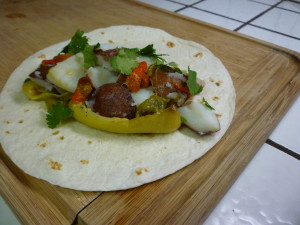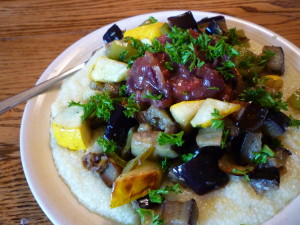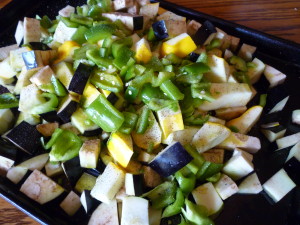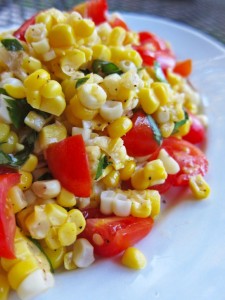Introduction
As the energy crisis and climate pollution deepens and the need becomes more acute to get local food production and a local food system up and running, we need to know about new ways of creating and operating farms. The 100% community based farm represents a completely new way to organize food production in contrast to the market based agricultural system that we have now which often does not take very good care of the farmer, the land, the climate, or the eaters.
When a group of eaters/prosumers come together and pool money to support the operating budget of a particular, local, diversified farm, and then share in eating the food that is produced, a stable economic basis is achieved which often cannot be achieved through the market system. In effect, the community of people eating from the farm are not buying food, but rather partnering with the farmer in creating and operating the farm. There are many roles they can play – from simply providing a share of the budget and eating the food to serving on an advisory board to define the farm crop plan, the farming and energy practices, address land and capitol issues, and facilitate communication through the newsletter, website, and member outreach and farm celebrations. Through this involvement, people can play a conscious and active role in forming and manifesting a new food system.
Associative Economics
In order to have a healthy agriculture we have to have a healthy economic process. The real cost of food is actually based on the cost of taking care of the needs of the farmer and the land on a long term sustainable basis which is often not indicated by the current market economic “bottom line”. The associative economic practices employed by CBF’s transform the economic process underlying agriculture from being directed by mechanistic “bottom line” self interest economic forces to an economic process which is directed by the good of the community as a whole – oriented towards meeting the needs of the earth, the farmer, and the eaters and reflecting human values and long term stewardship.
In practical terms this is accomplished through presenting the farm’s annual operating budget to the members and using it as a communication tool so that members can become aware of the actual costs of operating the farm and the state of its economic well being. The operating budget has the greatest clarity in a farm that distributes 100% of its produce through its members. If a farm is not wholly community based and has 75% of its product going to a member community and the other 25% going to markets, then it could possibly create some clarification by separating 25% of its gross income and expenses from the budget presented to members.
A farm that is operated with these associative economic practices is a social business which, although it may pay back initial investors, does not have a goal of paying dividends or accruing capital to private investors, and in that way is akin to a non-profit organization. It does have a goal of providing an adequate living for the farmers and maintaining the land and infrastructure in good condition. Also each farm is serving its member community and is not in competition with its neighbor farm when each farm has its own member base to carry the operation of the farm. In partnering with the farmer, the members share in the natural risks and benefits of the harvest and secure the development and future of local farms.
Proposal
This is a proposal for initiating and developing an organization in Mendocino county for educating the public about Community Based Farming and promoting development of local Community Based Farms.
This organization would:
- Promote awareness of CBF principals and practices through on farm field/education days at existing CBFs and presentations about CBF at “local food venues”.
- Ask for volunteers who would like to:
- Participate in administering the organization
- Participate in the initiative by becoming members of a CBF
- Participate by being CBF farmers in the CBF format.
- Collate the threshold number of members to provide the beginning economic base for a given farm operation and match with an appropriate farmer.
- Create land access for CBF farming through a Land Link type program which registers and facilitates matches between land owners/retiring farmers and farmers seeking farms/land.
- Enlist civic/gov. recognition and support.
- Organize/participate/present in education workshops on CBF for farmers; for members/core group members.
Community Based Farming Definition/Standard
a. Growing practices are broadly ecological-strengthening and healing the life forces of the earth and the air-ie.at least organic or biodynamic growing.
b. The farm distributes at least 50% of its produce through a member community and grows at least 75% of the produce on the farm.
c. The farm supports the development of conscious relationships between the members and the farm through core group/planning meetings, open house field days, farm celebrations or other direct interaction with members to encourage community awareness and cooperation.
d. Several farms cooperate with the same member community to offer a wider range of foods maintaining transparency of relationship by each farm making its own direct offering of, for instance, a vegetable supply, tree fruit, grains and beans, meat, winter vegetables, cheese, berries and nuts, vegetable oil, etc., rather than one farm acting asa middle man for unrelated farms.
Comments
Retail outlets, farmers markets, and CBFs all have important, but different rolls to fulfill in a local food system. They can be mutually complementary and we want to have and promote all of them. CBFs can create a secure staple food supply for members, but there will also be additional quantities or other items that members will obtain at stores or markets. Not all farmers want to incorporate the level of community and personal interaction that is a fundamental part of the CBF concept. Also beginning and less experienced farmers may be better off with the farmers market because they can focus on fewer crops and don’t have the pressure of trying to meet the needs of a committed community of members.
However, when a farmer reaches the point of wanting to produce food for people as a full time and long term vocation, then he/she will be looking for the economic stability that a CBF can generate so that the farmer can see a secure future in farming for themselves and the next generation. Also, because a CBF creates a much more conscious and committed relationship between the eater and the grower it has a much deeper capacity to educate people about agriculture and foster social change.
Currently there are people and organizations locally promoting retail and farmer’s markets on KZYX , in the papers, and with events. Now it is time to generate greater public understanding and awareness, and support for CBF so that it can develop and manifest a greater number of viable local farms.
Steve Decater, Live Power Community Farm, 2/23/08
Contact Sign Up List
Are you interested in promoting/participating in Community Based Farming in the county in the following ways?
Further discussion/administration
Becoming a member of a CBF
Becoming a CBF farmer
Attending/organizing CBF workshop
If so, please send us an email at livepower@livepower.org. Be sure to include your name, address, phone, and e-mail address.
 — Guest Post from Tarney Sheldon, Live Power Farm CSA Member —
— Guest Post from Tarney Sheldon, Live Power Farm CSA Member —



